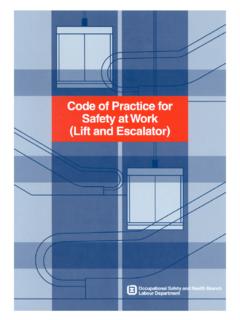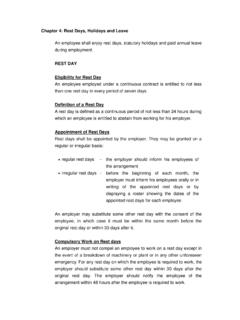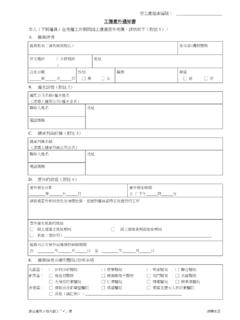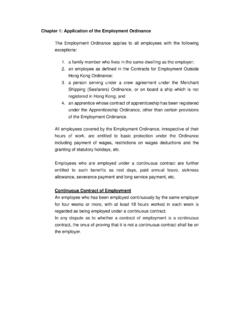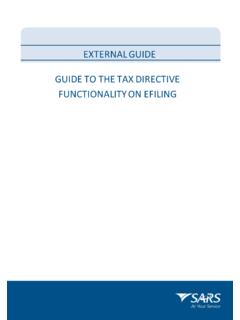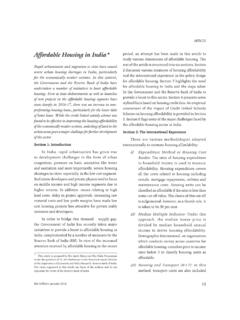Transcription of Distinguishing an “employee” from a “contractor or self-
1 To avoid misunderstanding or dispute, the relevant persons should understand clearly their mode of cooperation according to their intention and clarify their identities, whether they are engaged as an employee or a contractor/ self- employed person, before entering into a contract. This can safeguard mutual rights and an employee from a contractor or self- employed person There is no one single conclusive test to distinguish an employee from a contractor or self- employed person . In differentiating these two identities, all relevant factors of the case should be taken into account.
2 Moreover, there is no hard and fast rule as to how important a particular factor should be. The common important factors include: control over work procedures, working time and method ownership and provision of work equipment, tools and materials whether the person is carrying on business on his own account with investment and management responsibilities whether the person is properly regarded as part of the employer s organisation whether the person is free to hire helpers to assist in the work bearing of financial risk over business ( any prospect of profit or risk of loss)
3 Responsibilities in insurance and tax traditional structure and practices of the trade or profession concerned other factors that the court considers as relevant Since the actual circumstances in each case are different, the final interpretation will rest with the court in case of a should note An employee should identify who his employer is before entering into an employment contract. If necessary, before the commencement of employment, the employee may make a written request to the employer for written information on conditions of employment in accordance with the Employment Ordinance (EO).
4 The employee should also keep important documents such as tax demand notes, attendance cards and wage records, etc. Before an employee considers changing his status to a contractor or self- employed person, he must cautiously assess the pros and cons involved, including the employment rights and benefits that he may lose in such a change. An employer should not unilaterally change the status of his employee to a contractor or self- employed person without the consent of the employee. Otherwise, the employee may, depending on the circumstances, lodge a claim for remedies against his employer for unreasonable variation of the terms of the employment contract under the EO.
5 Moreover, the employee may also make a claim for termination compensation against his employer on the ground of constructive dismissal under common Contractor / self- employed Person? If an employee reasonably suspects that the employer has not taken out a valid employees compensation insurance policy, he should notify the Labour Department as soon as possible. Moreover, employees compensation insurance is only applicable to employees. A contractor or self- employed person should consider taking out a personal accident insurance policy with adequate coverage on his differences in the rights and benefits enjoyed by an employee and a contractor or self- employed person Rights and benefitsEmployee Note 1 Contractor or self- employed personEntitled to basic protection under the EO.
6 If engaged under a continuous contract Note 2, also entitled to employment benefits such as paid annual leave, statutory holiday pay, sickness allowance, severance payment or long service payment, etc. Entitled to protection under the Minimum Wage Ordinance, including the statutory minimum wage Entitled to protection under the Employees Compensation Ordinance, including sick leave and compensation arising from work injuries Entitled to protection under the Mandatory provident fund Schemes Ordinance.
7 Including employer s contribution Note 3 Employers should note An employer should not unilaterally change the status of his employee to a contractor or self- employed person without the consent of the employee. Otherwise, the employee may lodge a claim for remedies against his employer under the EO and common law. An employer should cautiously assess the risks involved before entering into a contract to engage someone as a contractor or self- employed person. If in essence there exists an employer-employee relationship, even though the worker is called a contractor or self- employed person or has been labelled as a self- employed person in the contract, the employer is still required to fulfil his responsibilities under the relevant legislation by paying back statutory benefits retroactively to the worker who is falsely labelled as a self- employed person.
8 Moreover, the employer may be criminally liable under the relevant 1 As to the application of individual ordinances, please refer to relevant 2 An employee who has been employed continuously by the same employer for four weeks or more, with at least 18 hours worked in each week is regarded as being employed under a continuous 3 A contractor or self- employed person should enrol in a Mandatory provident fund scheme and make contributions on his Court CasesCase 1Mr POON was an air-conditioning worker.
9 He suffered partial loss of vision in his left eye in an accident during the installation of an air-conditioner. The contracting company considered Mr POON a self- employed person and refused to pay compensation for his injury at work. Thus Mr POON made a claim to the court. After trial of his case by the District Court and the Court of Appeal of the High Court, Mr POON appealed to the Court of Final Appeal. The Court of Final Appeal finally decided that Mr POON was an employee of the Defendant Company and the Defendant Company had to pay him compensation for his injury at work.
10 The grounds of judgement were as follows:1. Since the air-conditioning business belonged to the Defendant Company, Mr POON bore no financial risks. He only received daily-rated remuneration. Whenever items had to be purchased for work purposes or travel expenses were incurred in the course of the work, he was reimbursed by the Defendant Company;2. The Defendant Company decided which jobs should be assigned to Mr POON and paid him at the agreed daily rate, plus any overtime pay.
